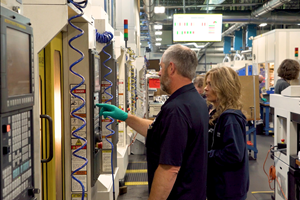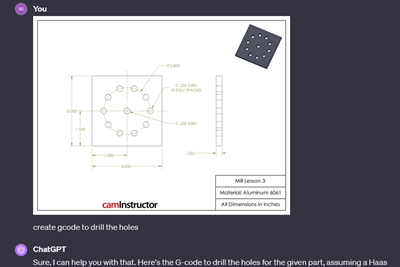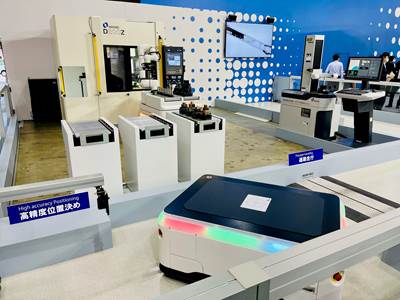Share






Hwacheon Machinery America, Inc.
Featured Content
View More



The 2024 Japan International Machine Tool Fair (JIMTOF) was held November 5-10, 2024 at the Tokyo Big Sight convention center. Photos provided by Modern Machine Shop.
As technology develops, the manufacturing industry adapts not only to new parts that need to be made, but also to new, more efficient ways of making these parts. Examples of both were on display at the 2024 Japan International Machine Tool Fair (JIMTOF), held November 5 through 10, 2024 at the Tokyo Big Sight convention center.
At the show, the continued influence of electric vehicle manufacturing on the automotive industry was evident, with machine tool suppliers promoting large-format machines that can handle large “gigacastings,” as well as friction stir welding (FSW) technologies, both of which will help carmakers reduce part weight and make these vehicles more energy efficient. At the same time, as artificial intelligence and autonomous robot technologies advance, machine tool suppliers are finding new applications that can make manufacturing more efficient.
Large-Part Manufacturing, Particularly Automotive Gigacastings for EVs and Hybrids

Large-part machining solutions for electric vehicle components such as gigacastings were common throughout the event. The EV frame in Mazak’s booth included an aluminum subframe produced on its new FF-1250H horizontal machining center, designed specifically for large aluminum workpieces.
At the 2024 JIMTOF international media press conference, JMTBA President Kazuo Yuhara acknowledged that, while Japanese automakers (similar to their counterparts in the US) have slowed or suspended production of full electric vehicles, they are continuing to move ahead with hybrid and plug-in hybrid vehicles. “Plug-in hybrid, as well as hybrid vehicles, are to some extent repositioning themselves in the stalling that we see in battery-charged EVs,” he says. However, Yuhara believes that the 2030s could see a resurgence of EVs. But in the meantime, he predicts “we will have impact coming from the demand coming from those ends of the spectrum,” that is, both combustion engines and EVs.

Large parts also require large robots. FANUC demonstrated one of its largest robots, the M-1000, simulating the process of spraying mold release agent onto a gigacasting press.
Accordingly, the machine tool industry is continuing to adopt technologies suited to hybrids and EVs, including technologies for large-part manufacturing, which Yuhara says will be useful for automotive manufacturers as gigacastings replace weldments in these vehicles for weight savings.

Komatsu’s booth featured this car rear-body gigacasting, which was machined on its new KV420L. The machine has twin spindles, a tilt table and a tilt traveling axis to process large parts in a smaller footprint.
On the show floor, a demonstration at FANUC’s booth simulated one of its largest robots, the M-1000, spraying a mold release agent onto a gigacasting press. Komatsu was exhibiting the KV420L, a new twin-spindle vertical machining center for large parts, such as the car rear-body gigacasting on display in its booth. In addition to the twin spindles, the machine also features a tilt table and tilt traveling axis to reduce the machine’s footprint while enabling users to process larger parts quickly and with fewer setups. Mazak’s booth featured an EV frame, which was composed of subcomponents produced on different Mazak machine tools, such as an aluminum subframe produced on the new FF-1250H (an HMC with a tilting rotary table and HSK-A100 for machining large aluminum workpieces).
Friction Stir Welding

Yamamoto’s Multi Intelligence for friction stir welding uses sensors in the machine spindle to measure temperature and load.
While Yuhara noted that the EV industry will drive an increase in gigacastings to replace weldments, friction stir welding (FSW) seemed to be an exception. Not only can this process reduce the size and weight of components by assembly consolidation, it’s also more durable than conventional joints with sealants and bolts.

Multi Intelligence analyzes and visualizes the data it gathers and determines optimal welding conditions. The bottom and right weld was created without Multi Intelligence, while the left and top weld was created with it.
The EV frame in Mazak’s booth also included components (an inverter case and battery case) created through friction stir welding. The companydisplayed two “hybrid multi-tasking” machines with milling and friction stir welding technologies: the FSW-460V with a 900- by 460-millimeter table, and the FJV-60/80 FSW double-column machining center with friction stir welding and a 2,240- by 1,250-millimeter table. FANUC demonstrated an M-800 that can be equipped with a machining head or a friction stir welding head. The robot’s rigidity enables it to withstand the downward forces of both the machining and the FSW process. And Yamamoto showcased its Multi Intelligence technology, which is available for both milling and friction stir welding. Both technologies feature sensors in the spindle (measuring temperature, vibration and cutting force in the case of milling; and temperature and load for friction stir welding). This data can be visualized and analyzed to determine optimal cutting or welding conditions.

These inverter cases in Mazak’s booth were produced on its FSW-460V hybrid machine tool, which features friction stir welding and machining capabilities.
Artificial Intelligence

Nagase’s new Integrex AI tool simulates processing conditions for grinding operations so operators can select the best parameters for a job, then monitors conditions during grinding and adjusts as necessary.
Artificial intelligence was an unavoidable topic in 2024, and JIMTOF was no exception. But according to Yuhara, these current applications only scratch the surface of AI’s possible capabilities. “I believe it is still limited at this point in time to only perhaps part of the potential functions that we could possibly deliver and provide. However, within a time span of five to 10 years, we will see more drastic functionality evolve,” he said.

This FANUC robot was picking randomly oriented parts out of a bin and placing them on a conveyor belt with the help of AI.
Nagase debuted its Integrex AI tool for grinding at the show. Integrex uses AI to simulate processing conditions so operators can select the best parameters for a job. The tool also monitors conditions during the machining process and adjusts the process as necessary. Operators also have access to AI-aided support to answer questions and troubleshoot grinding processes. FANUC showcased two AI technologies: an AI-powered bin picking system, where a robot with a vision system was picking randomly oriented parts from a bin and placing them on a conveyor belt, as well as a robot using AI-generated paths. Users teach this system the features of the parts, and it generates paths automatically. According to FANUC America Corporation President Mike Cicco, it’s particularly well-suited to the automotive industry. DMG MORI is also using AI to reduce warm-up operations by optimizing thermal displacement compensation. This not only allows stable machining without a warm-up cycle, but it also reduces power consumption.
Autonomous Robots

This AMR from Cocobo was performing security patrols between the halls at the Tokyo Big Sight convention center.
Yuhara noted that capital expenditures for addressing the labor shortage in Japan are particularly robust, as was evidenced by the number of automation systems on display. Autonomous robots in particular abounded at Tokyo Big Sight. This included the spaces between the halls, where AMRs from Cocobo were performing security patrols.

This Automation Cube One from Haimer is being tended by DMG MORI AMR 2000s to bring automatically assembled tools to machines.
On the show floor, many machine tool manufacturers featured applications for autonomous robots. Notably, most of the applications shown were not machine tending. Instead, the manufacturers primarily focused on peripheral, but essential tasks that keep machines running such as chip removal and tool changing.

Shin Nippon Koki (SNK)’s automated system for inserting tools and exchanging attachments from a centrally managed stocker to a flexible manufacturing system used an AGV and an industrial robot.
DMG MORI’s booth included autonomous robots demonstrating both of these applications. One showed Haimer’s Automation Cube One being tended by DMG MORI AMR 2000s. The Automation Cube One uses cobots to automate tool assembly with Haimer’s PowerClamp system and can also incorporate tool presetting and balancing. The booth also showcased its AMR 2000 Chips system, which automates removal of chip bins via pick-up orders from the machine control. Shin Nippon Koki (SNK) demonstrated an automated system for inserting tools and exchanging attachments from a centrally managed stocker to a flexible manufacturing system using an AGV and industrial robot. Sodick’s booth included an autonomous robot demonstration that involved moving workpieces, in which an AMR transferred workpieces from a wire EDM to a sinker EDM, then to a CMM.

Unlike many AMR demonstrations at the show, which involved tool and chip management, Sodick’s autonomous robot demonstration transferred workpieces from a wire EDM to a sinker EDM to a CMM.
Related Content
Leveraging Data to Drive Manufacturing Innovation
Global manufacturer Fictiv is rapidly expanding its use of data and artificial intelligence to help manufacturers wade through process variables and production strategies. With the release of a new AI platform for material selection, Fictive CEO Dave Evans talks about how the company is leveraging data to unlock creative problem solving for manufacturers.
Read MoreProtecting Your Automation Investments
Shops need to look at their people, processes and technology to get the most of out their automation systems.
Read MoreShop Quotes Smarter, Works Harder with Machine Monitoring
Temco first installed MT-LINKi to optimize quoting. Now, the software helps the shop optimize its machines — and machine purchases.
Read MoreEasy-To-Install Data Acquisition System for Real-Time Monitoring Across Brands
cnSEE from All World Machinery Supply combines easy installation and monitoring across multiple machines.
Read MoreRead Next
Data Fuels Robotics Research
At Mill 19, the site of the Advanced Robotics for Manufacturing Institute and Carnegie Mellon University’s Manufacturing Futures Institute, robotics data provides the foundation for AI and digital twins.
Read MoreCan ChatGPT Create Usable G-Code Programs?
Since its debut in late 2022, ChatGPT has been used in many situations, from writing stories to writing code, including G-code. But is it useful to shops? We asked a CAM expert for his thoughts.
Read MoreIntegration, Automation and Green Tech Highlight JIMTOF 2022
Known as one of the largest machine tool trade shows in the world, the Japan International Machine Tool Fair (JIMTOF) has a reputation for being a machining technology show more than a machine tool sales event. And this year’s show in Tokyo — the first in-person Japanese machine tool trade show in four years — did not disappoint.
Read More












































